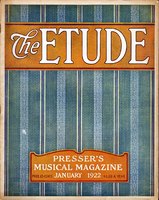Selected Content from the January 1922 Edition of The Etude
These valued opinions were sent in response to the following questions:
Would I Want my Son or my Daughter to Make Music a Career?
Would I Take Up Music if I were Beginning my Work Again? Read More
Howard H. Hansen, dean of the College of the Pacific Conservatory has been awarded the three year fellowship established in the name of Frederic A. Julliard and known as the American Prix de Rome. This entitles him to three… Read More
If given a certain page of music to study, the average pupil plays it through time after time in the hope that it will improve of itself, the Sevcik method would be to play it through at speed, and to observe the places that do not go well, or at all. Having picked out the difficult passages, the pupil then commences to dissect them to see what the difficulty really is, and if it is a combination of difficulties, to master them one by one, and then combined. A favorite prescription of Sevcik’s is: “Jede Vier Noten Hia Und Zurúck.” That means “every four notes forward and backwards.” It is not so unusual to find some pianist who has taken four notes of a passage, then the next four notes, and so on. But to Sevcik that was objectionable. He wanted the first four notes, then the four notes starting with the second note, then four notes starting with the third note, and always forwards and then back. In other words if we call the first four notes one, two, three, and four, the order of practice would be: one, two three four, four three two one, — first very slowly, and gradually more rapidly, until the four notes can be played more rapidly than the tempo calls for. Then two, three four five, — five four three, two, — and so on to the end of the passage. Read More
The music life is like a mighty current. Its enthusiasts find themselves carried down the stream of their artistic enthusiasm by a force so great that only the most powerful can survive. If the composer is satisfied to wade in calmer waters he knows that his artistic results will be proportionate. It is the mighty struggle, the terrific fight of man with the psychic and cosmic forces of the age in which he is working that produces the great master. Read More
An Intimate Page of Facts, Humor and Comment with the Great Music Makers of To-day and Yesterday By THE RECORDER That Schumann-Heink is a born mother is a fairly well established fact. It is a question… Read More
The broad divisions of music are known as: Sacred, Secular, Classical, Romantic, Modern, Dance Music. There are also divisions of music, plainly defined, known by their nationality: Italian, German, Russian, French, etc. These divisions comprise in turn:—Sacred: Chant, Psalm, Hymn, Choral, Anthem, Motet, Mass, Oratorio. Secular: Folk-Song, Song, Ballad, Romance, Aria, Glee, Madrigal, Cantata, Opera. All the foregoing may be considered as vocal and as vocal and instrumental music combined. Then we have in instrumental music:—Classical: Suite, Sonata, Sonatina, Overture, Fantasia, Symphony, Concerto, with movements of Rondo, Scherzo, etc. Romantic: the majority of the works of Weber, Schubert, Spohr, Mendelssohn, Chopin, Berlioz, Liszt, Wagner, etc. The most distinctly Modern are the French and Russian schools. Of the old Dances are all those found in the Suites, such as the Minuet. Gavotte, Chaconne, Passacaglia, etc., while the new Dances comprise the Polka, Mazurka, Schottische, Waltz, Galop, Polonaise, Quadrille, etc. Read More
It is not necessary for me to advise America as to the matter of musical ideals. There are horrible perversions in all parts of the world. One of the greatest abuses I have observed since my visit to this country has been the deliberate pilfering of the great musical masters of the past to make some popular tune. If there must be prohibition, why not make a law to prevent such desecration. The other night I heard in a hotel in Pittsburgh the lovely Blue Danube Waltz of Johann Strauss murdered in some popular tune in which it appeared in four quarter time. I am told that this is not only common but that popular publishers in keeping with the banditry of the times are making a continual practice of it. The bad effect upon the art and upon the student of the art is that it belittles the need for creating original melodies. When it is so easy to steal, why produce? Read More




